Windows 10 and 11 assure a smooth user experience, no doubt about it! However, it feels really annoying when the “failed to enumerate objects in the container” error message pops up on your system when you try to access a specific folder, isn’t it?
The accessibility error can be solved just by updating your Windows OS and temporarily disabling the Windows Defender. Besides you can also restart your system in safe mode or give it a clean boot. Moreover, you can perform the “Chkdsk” and “DISM” commands to resolve this issue as well.
However, these are not all the solutions we have to fix this issue. But before we dig deeper into the solution part, let’s understand what this error actually is and what are the primary reasons behind this error.
What Are The Main Reasons Behind the “Failed To Enumerate Objects in the Container” Error?
The “failed to enumerate objects in the container” error is pretty common, especially when you try to access a folder over a LAN connection. However, this error message typically shows up for six main reasons, which are as follows.
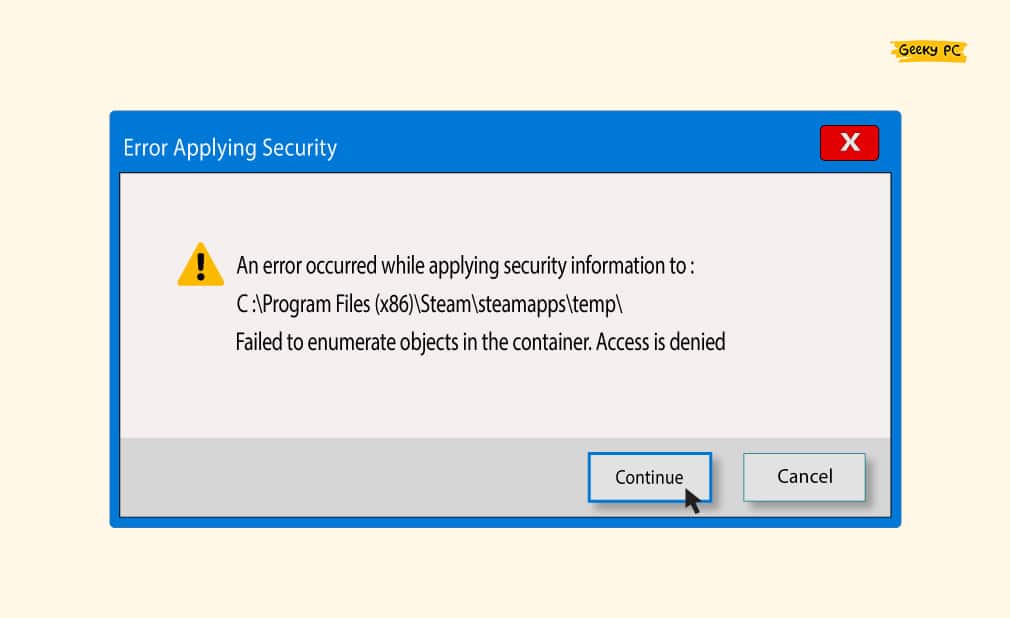
- You are using an outdated variant of Windows OS that needs an urgent update to run properly.
- The Windows Defender or any other third-party antivirus is restricting your system from accessing the folder.
- There is a mismatched file access permission assigned to the affected folder.
- There are bad or corrupted sectors in your hard drive.
- Any of the startup app or background processes restrict the user account from gaining control of the folder.
- You don’t have ownership access to the affected folder.
Besides these six main reasons, this accessibility error can even pop up if you have conflicting access permission for the folder.
It can even happen if you have accidentally removed the ownership of the folder from your user account.
5+ Easy Fixes For The “Failed To Enumerate Objects In The Container” Error
Before you try anything fancy, such as modifying your system settings or running some specialized tools, you need to first try the generic fixes.
And in almost 90% of cases, these generic fixes alone are sufficient to resolve the “failed to enumerate objects in the container” error in Windows devices.
1. Restart Your Device In Safe Mode
You may start getting access errors on Windows devices if too many third-party apps or startup applications are running on your device. It may sometime happen that any of those third-party applications start interfering with the system files.
So, it is better to restart your device in safe mode to eliminate interference issues.
- Step 1: Press the “Windows Key + I” buttons together to launch the “Settings” app on your system.
- Step 2: Once the new window appears, scroll down, and click on the “Update & Security” option.
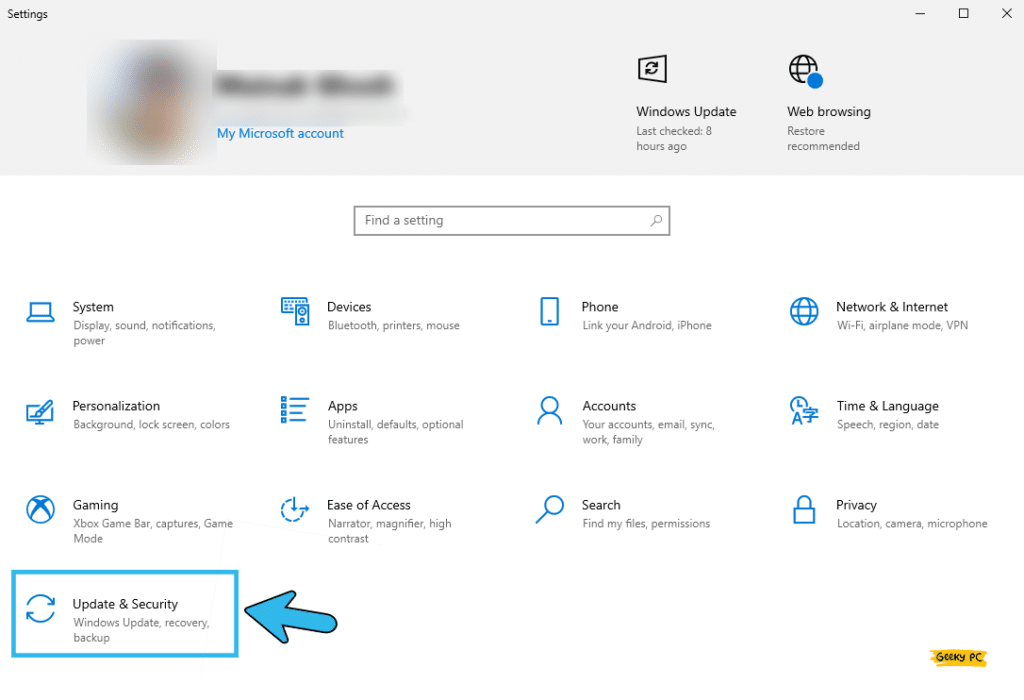
- Step 3: After the new page launches, navigate to the left panel, and click on the “Recovery” option.
- Step 4: Now, navigate to the right panel, locate the “Advanced Startup” option, and click on the “Restart” button under that header.
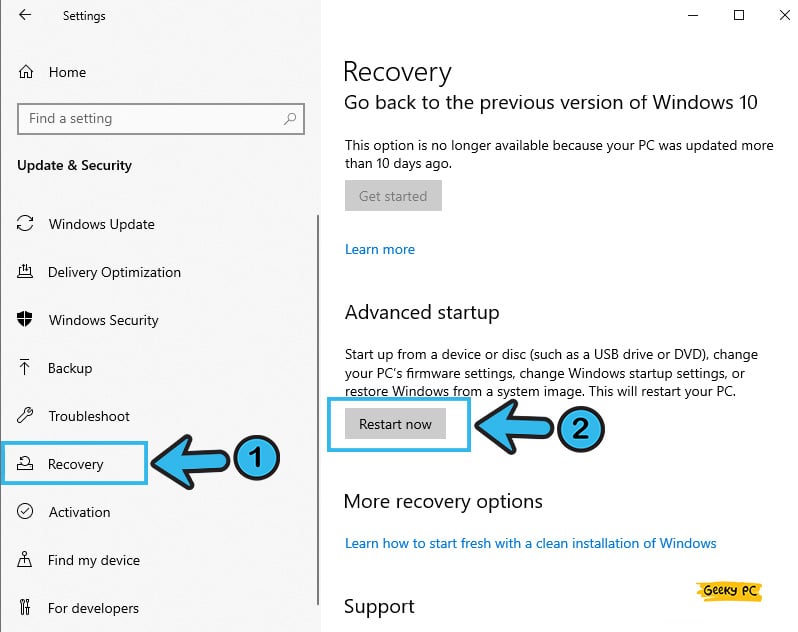
- Step 5: Let the window reboot itself and select the “Safe Mode” option from the boot menu.
- Step 6: Once your OS fully reloads in safe mode, check whether you are still getting the same error.
A few of our users have started getting an unresponsive start button once they have rebooted their device into safe mode, especially on Windows 11 devices.
If you are also facing a similar situation on your system, follow our detailed guide to fix the start button on Windows devices.
2. Opt For A Clean Reboot
You may get the “failed to enumerate objects in the container in windows server” error if you have too many startup applications running in the background of your system.
So, it is better to give your system a fresh reboot in clean mode to minimize interference from third-party apps.
- Step 1: To launch the “Run” dialog box, press the “Windows Key + R” buttons together.
- Step 2: Type “msconfig” in the Run dialog box and click on the “OK” button.
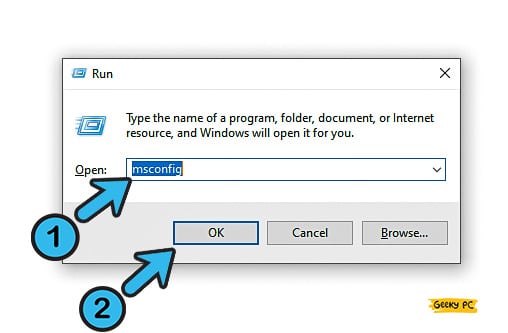
- Step 3: After the “System Configuration” window pops up, navigate to the header selection menu, and select the “General” option.
- Step 4: Click on the small box beside the “Selective Startup” option.
- Step 5: Navigate to the “Selective Startup” header and uncheck the box beside the “Load Startup Items” option.
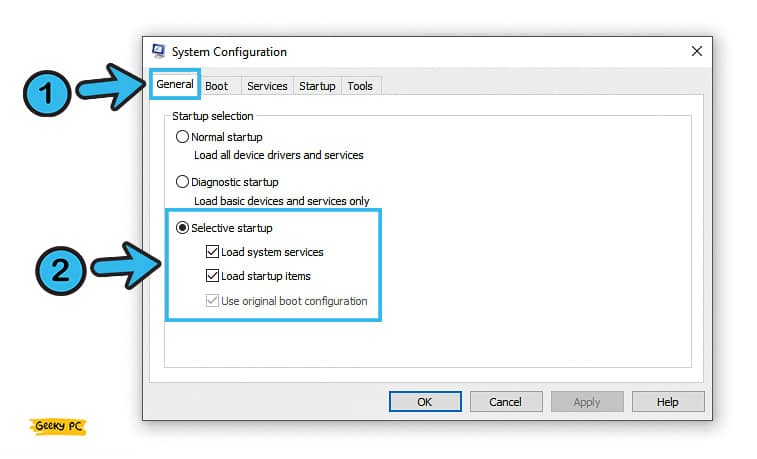
- Step 6: Now, navigate to the “Services” tab from the header menu.
- Step 7: Check the box beside the “Hide all Microsoft services” option.
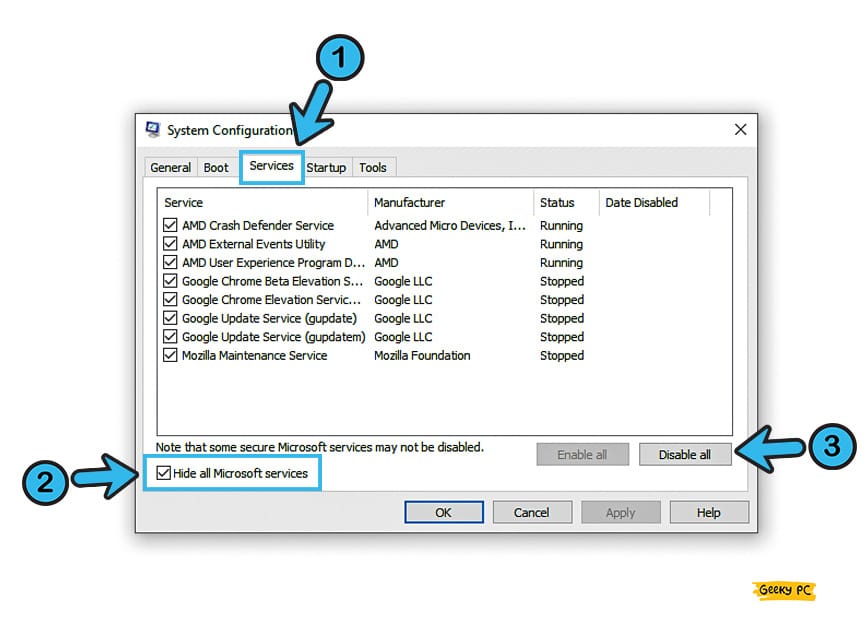
- Step 8: Once you get the entire list of startup apps, click on the “Disable All” button.
- Step 9: Navigate to the header selection menu, select the “Startup” tab and further click on the “Open Task Manager” option.
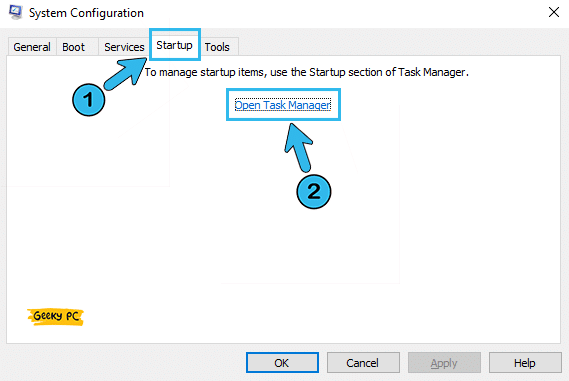
- Step 10: Once the “Task Manager” window appears, right-click on each item and select the “Disable” option from the contextual menu.
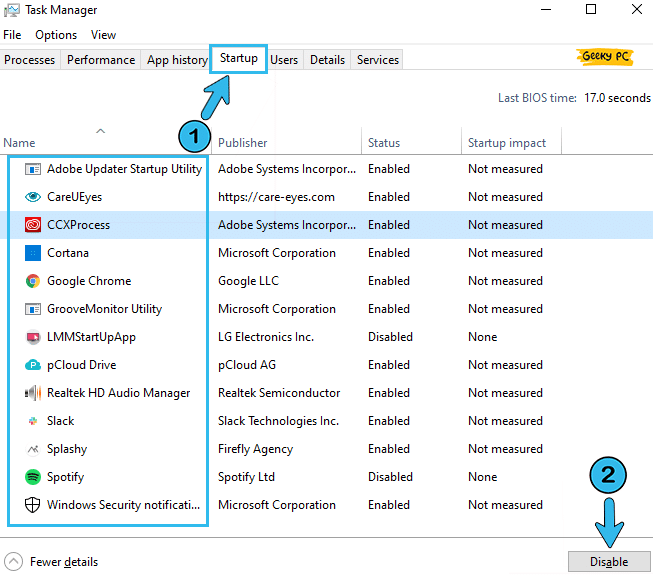
- Step 11: After you have disabled all the items, click on the “OK” button to save the settings.
- Step 12: Exit from the “Task Manager” app and reboot your system.
In some of our users’ systems, a yellow triangle on the LAN icon suddenly starts to appear, denoting an ethernet error once they have rebooted their system into clean mode.
3. Update Your Windows OS
You may start to get the “failed to enumerate objects in the container” error in windows 11 if the update is long due on your system.
Besides, several other bugs and errors can start to appear on your device if you don’t update your OS on a regular basis. So, you should update it ASAP before trying anything else.
- Step 1: Click on the “Magnifying Glass” icon located at the bottom-left corner of your taskbar.
- Step 2: Once the “Search” field appears, type “Window Update” in the designated box and select the very first option that appears.
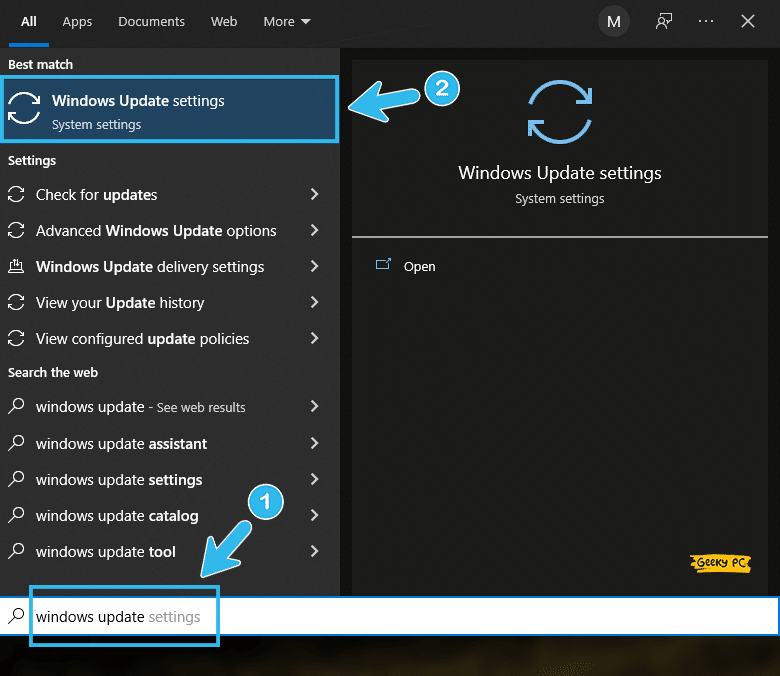
- Step 3: After the “Update” window launches, navigate to the left panel, and click on the “Windows Update” button.
- Step 4: Now, navigate to the right panel, and click on the “Check for updates” button.
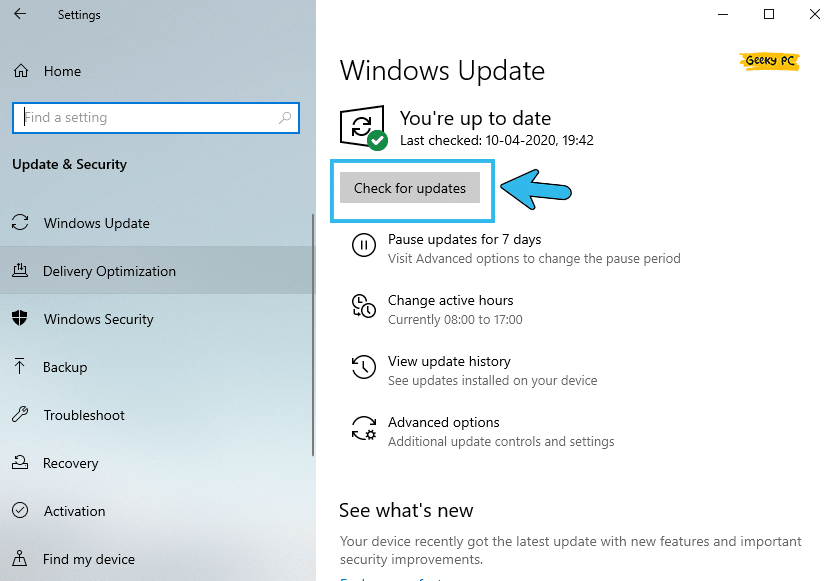
- Step 5: Let Windows find and download the latest update patch from the Microsoft server.
- Step 6: Reboot your system once the updates are completely installed on your system.
Many people have started getting an unresponsive taskbar once they have rolled out the newest update of Windows 10 and 11.
4. Disable Windows Defender
There is no doubt that Windows Defender antivirus is truly a robust security software that now comes preinstalled with the latest generation of Windows OS, especially Windows 10 and 11.
However, this software can start interfering with your system file at times. So it is better to disable it temporarily.
- Step 1: To launch the “Settings” app on your system, press the “Windows Key + I” buttons together.
- Step 2: Scroll down at the bottom of the window and select the “Update & Security” option.

- Step 3: After the new window appears, navigate to the left panel and click on the “Windows Security” option from the list.
- Step 4: Now, navigate to the right panel and click on the “Virus & threat protection” option.
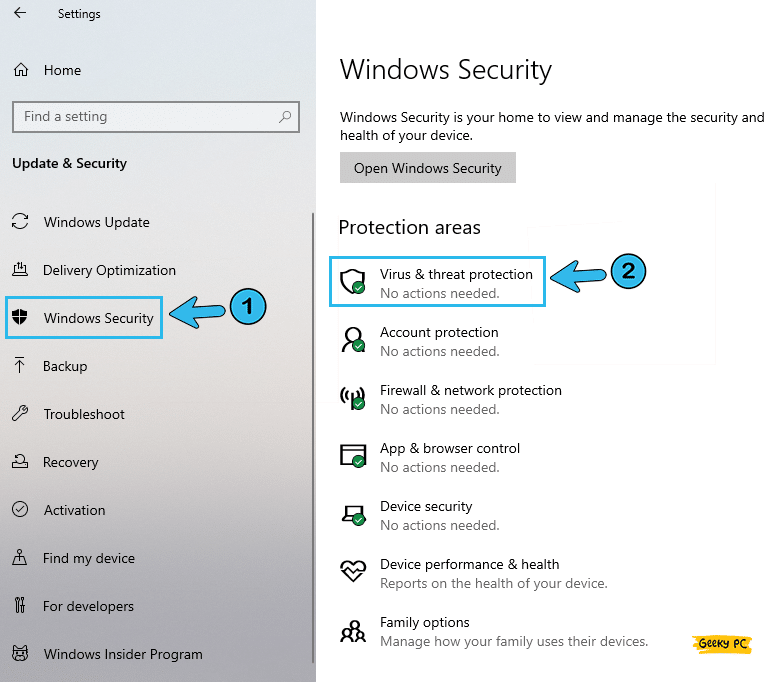
- Step 5: After the new window launches, select the “Virus & threat protection settings” option.
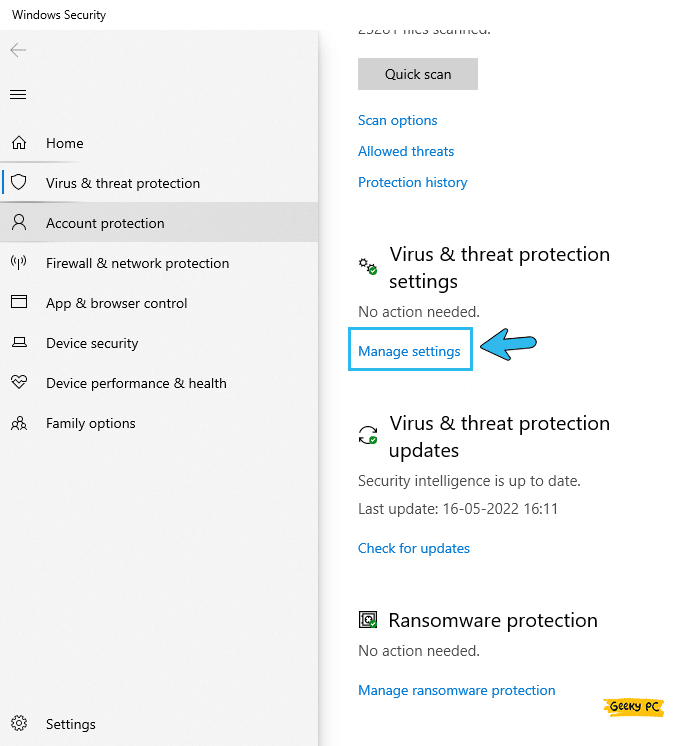
- Step 6: Now, click on the toggle switch beside the “Real-time protection” option to disable it.
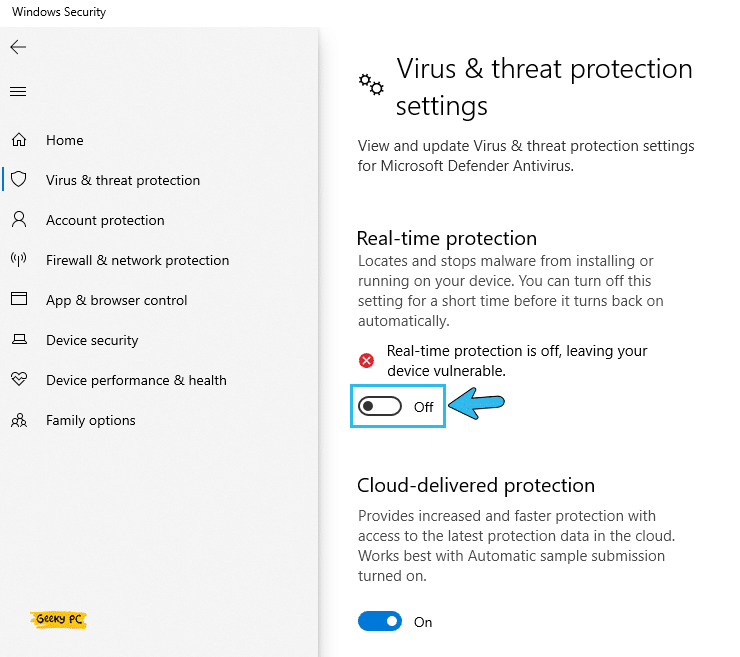
- Step 7: Press the “OK” button to save the settings and exit the app.
A few of our users have reported getting a group policy error once they have disabled the Windows Defender antivirus on their system, especially while using their device under a system administrator.
If you are also facing the same, follow our step-by-step guide to resolve the “We Couldn’t Complete The Updates Undoing Changes” error in Windows devices.
5. Disable UAC Warning Message
If you doubt a false alert where you think the access error message pops up on your device without any reason, you can manually disable the warning message from appearing on your system. And you can do it in a few simple steps from UAC (User Access Control).
- Step 1: Click on the “Magnifying Glass” icon located at the bottom-left corner of your taskbar.
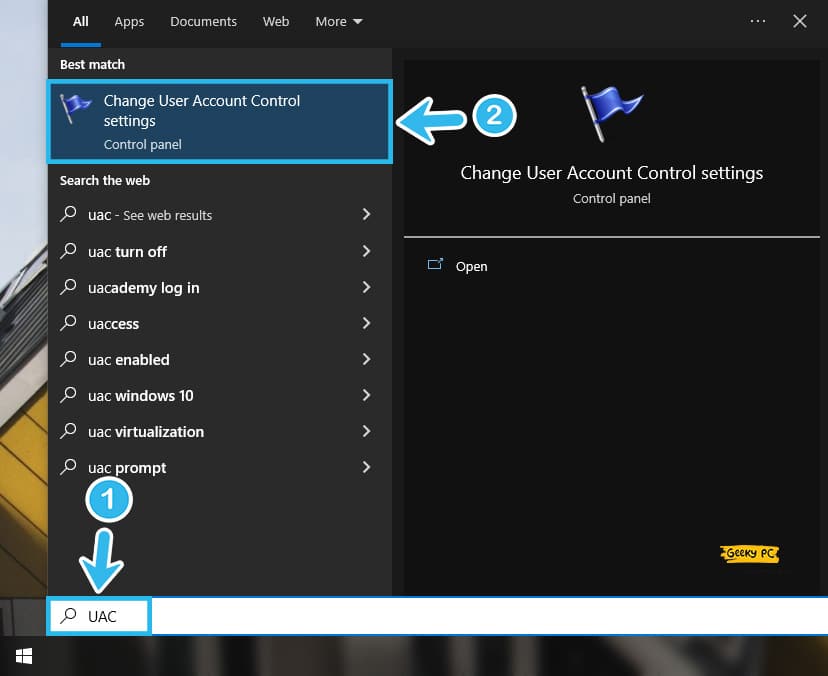
- Step 2: Type “UAC” in the designated field and click on the very first result that shows up.
- Step 3: Once the “Change User Account Control Settings” window appears, navigate to the slider.
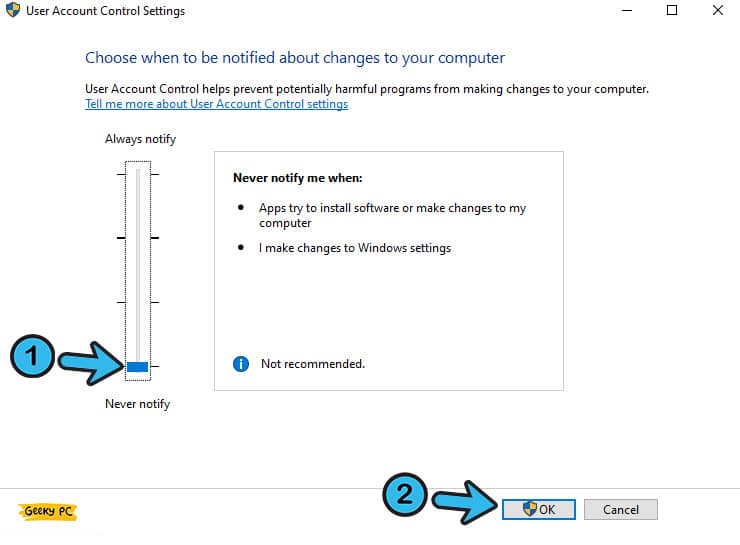
- Step 4: Now, drag the slider at the bottom to select the “Never Notify” option.
- Step 5: Press the “OK” button to save the settings and exit the app.
- Step 6: Reboot your system and check whether you are still getting the same error message.
It is not a wise decision to permanently disable the user notification on Windows devices. You may miss some of the most critical error messages if you do so.
So, it is better to disable it first, find the root cause of this container error, and then reenable it to allow error messages to appear on your screen.
5+ Advanced Fixes For The Folder Access Error In Windows Devices
If none of the above generic methods are working to resolve the “failed to enumerate objects in the container” error, the problem may be way deeper than you can possibly assume. And in that case, resorting to advanced fixes is the only option left to resolve this issue.
6. Check Bad Sectors On HDD
Not just for the apps and background processes, the container error in Windows devices can even trigger if you have any bad or corrupted sector on your primary HDD or SDD. So, you need to check your hard drive first to know whether a bad sector mainly triggers the issue.
- Step 1: Press the “Windows Key + R” buttons together to initiate the “Run” dialog box.
- Step 2: Type “CMD” in the designated dialog box and click on the “OK” button to launch the app.
- Step 3: Once the black “Command Prompt” window appears, type “chkdsk /r c:” (If the default system drive is “C:” on your device) and press the “Enter” button.
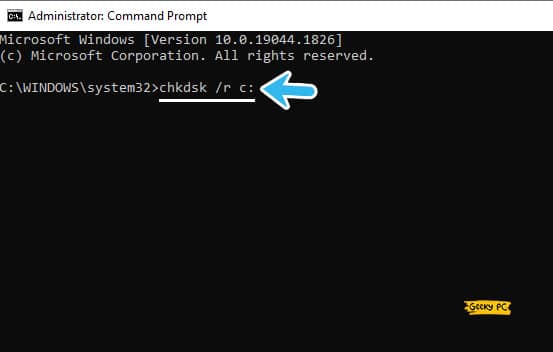
- Step 4: Now, let the disk checker tool automatically find and fix the bad sectors on your HDD or SDD.
- Step 5: Once the disk checking is over, type “Exit” and hit the “Enter” button to close the “Command Prompt” window.
- Step 6: Now, reboot your device and check whether you are still getting the container error.
Some of our users have reported getting a major gateway error once they have performed the check disk operation on their systems, especially while they use a static IP connection.
If you are also facing the same, follow our detailed guide to the “Wi-Fi Keeps Disconnecting” error in Windows systems.
7. Disable User Account Control
The administrative privilege error in Windows devices mainly occurs when you have mismatched user account control. Besides, it can also appear if you have any bug or error on the UAC app itself.
So, to minimize that issue, you can manually disable the user account control on Windows 10 and 11.
- Step 1: Press the “Windows Key + S” buttons together to launch the search field on your device.
- Step 2: Type “UAC” in the designated box and click on the very first result that appears in the window.

- Step 3: Once the “Change User Account Control Settings” app launches, navigate to the vertical slide.
- Step 4: Now, drag the slider to the second last position, where it shows the “Notify me only when apps try to make changes to my computer (do not dim my desktop)” option.
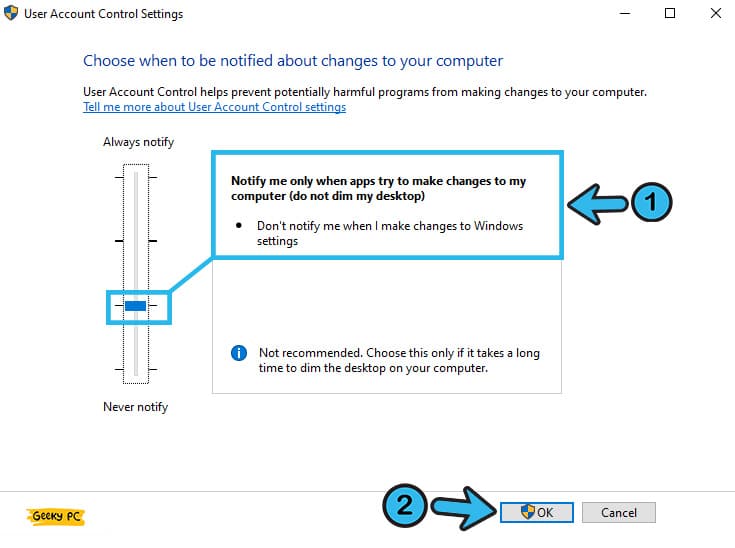
- Step 5: Click on the “OK” button to save the settings and exit from the “UAC” app.
- Step 6: Now, reboot your system and check whether you are still getting the same error message.
As we have already said, it is not a wise decision to alter the “User Account Control” settings on windows devices, especially if you frequently connect to open networks.
Otherwise, you may overlook critical messages on your device. So, it is better to reenable it in the default mode once you sort out the container error on your system.
8. Run DISM Scan On Your Device
DISM, or Deployment Image Servicing and Management, is a command-line tool that now comes preinstalled on the latest Windows devices, such as 10 and 11.
And, if you are getting the “failed to enumerate objects in the container” error too frequently, you should perform the DISM scan on your device.
- Step 1: To launch the “Run” dialog box on Windows devices, press the “Windows Key + R” buttons together.
- Step 2: Type “CMD” in the designated run field and click on the “OK” button.
- Step 3: After the black “Command Prompt” window launches, type the “DISM /Online /Cleanup-Image /StartComponentCleanup” command.

- Step 4: Now, hit the “Enter” button after the command line to initiate the operation.
- Step 5: Once the component clean-up is done, type the “Dism /Online /Cleanup-Image /ScanHealth” command, and hit the “Enter” button again.
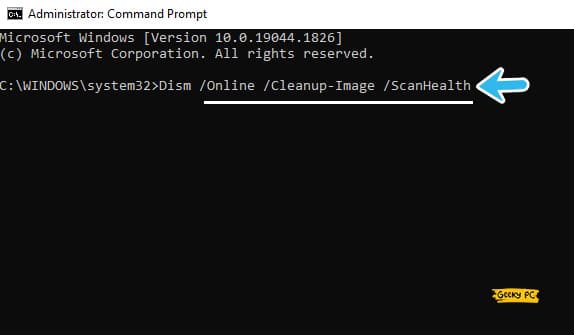
- Step 6: Lastly, type the “DISM.exe /Online /Cleanup-image /Restorehealth” command and hit the “Enter” button again.
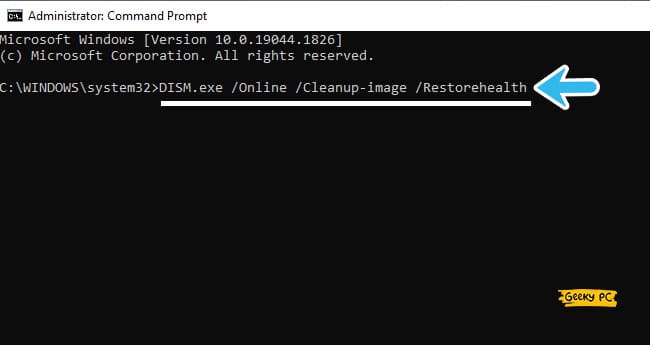
- Step 7: Once all three operations are over, type “Exit” and press the “Enter” button to close the “Command Prompt” window.
- Step 8: Now, give your system a fresh restart and check if you are still getting the same issue.
Before performing any of the DISM command lines, you should first disable the Windows Defender antivirus. This robust security software can effectively block the DISM tool from accessing root installation files on your device.
However, you shouldn’t disable the antivirus for too long.
9. Manually Change The Folder Ownership
If none of the above methods are working to resolve the container access error, you can manually change the ownership of the folder altogether.
And by doing that, you can effectively regain ownership of the folder to allow access from your Windows user account.
- Step 1: Right-click on the folder where you are getting this error and select the “Properties” option from the contextual menu.
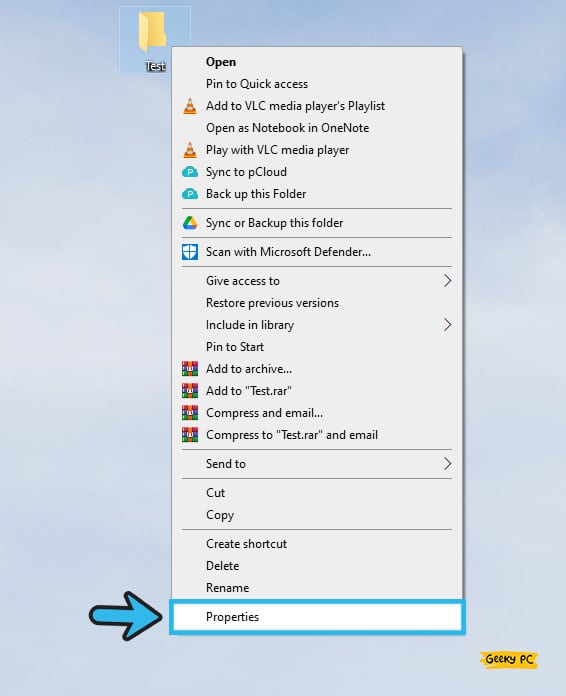
- Step 2: Navigate to the “Security” tab from the header selection menu.
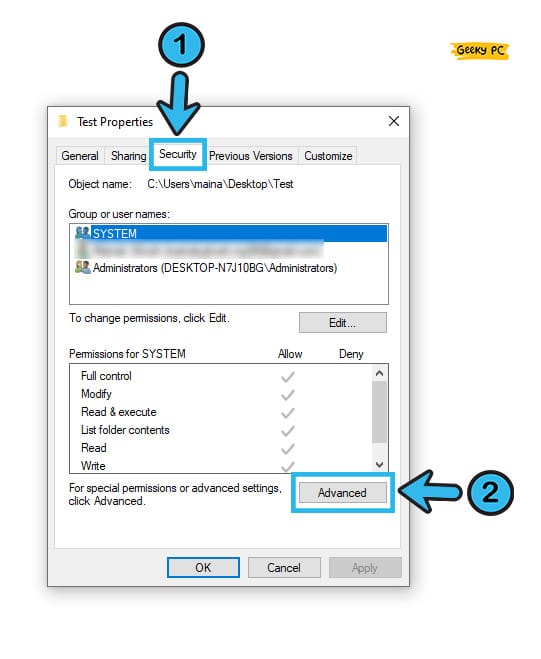
- Step 3: Locate the “Advanced” button at the bottom of the window and click on it.
- Step 4: Click on the “Change” button located just beside the file’s actual owner name (Typically in the second line of the window).
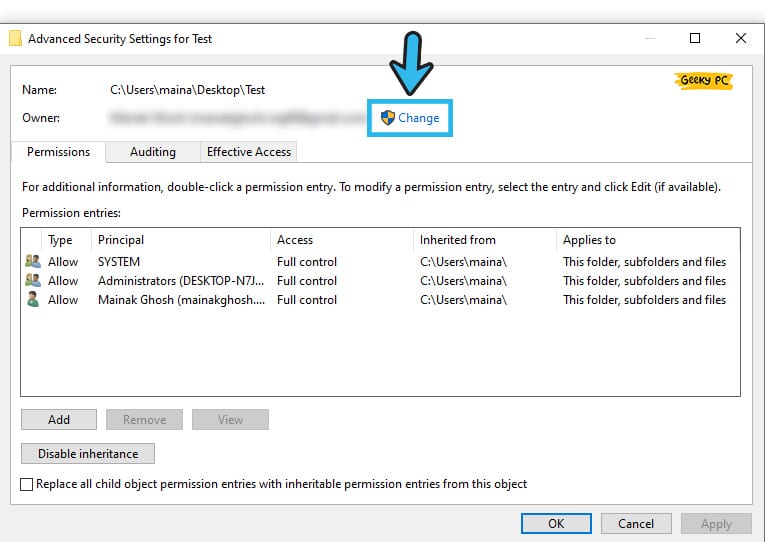
- Step 5: Type out your account name in the box under the “Enter the object name to select” header.
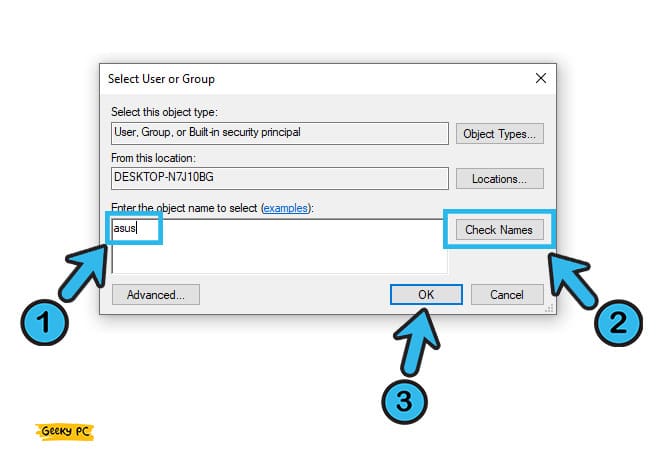
- Step 6: Now, click on the “Check Names” button and see if your account name gets underlined.
- Step 7: If it is underlined, click on the “OK” button to proceed further.
- Step 8: Once the new window appears, enable both the “Replace owner on sub containers and objects” and “Replace all child object permission entries with inheritable permission entries from this object” options.
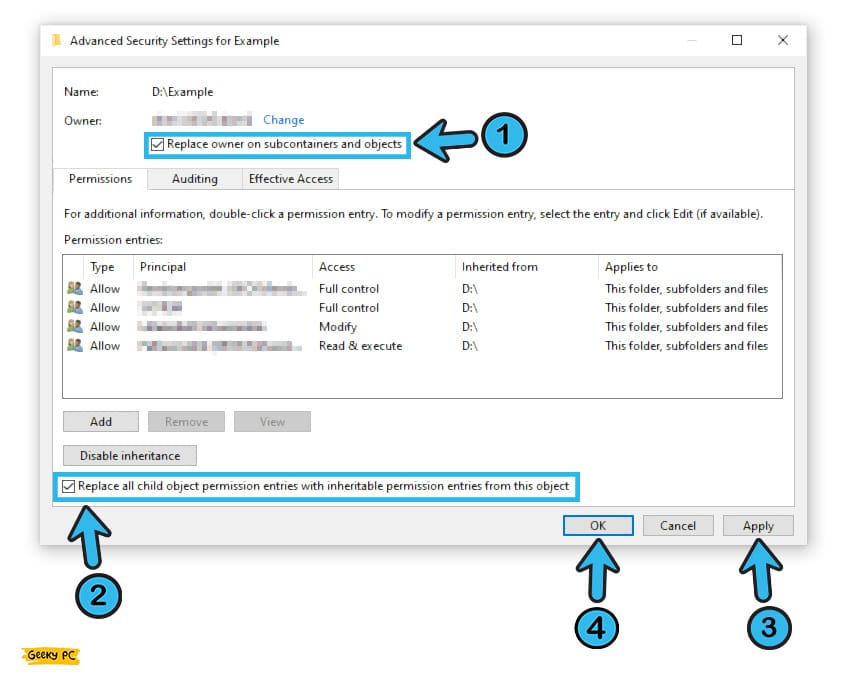
- Step 9: Click “Apply” to save the settings and then navigate to the Security tab, and then the “Advanced” option again.
- Step 10: Now, click on the “Add” button located at the bottom-left corner of the window and click on the “Select A Principal” link option.
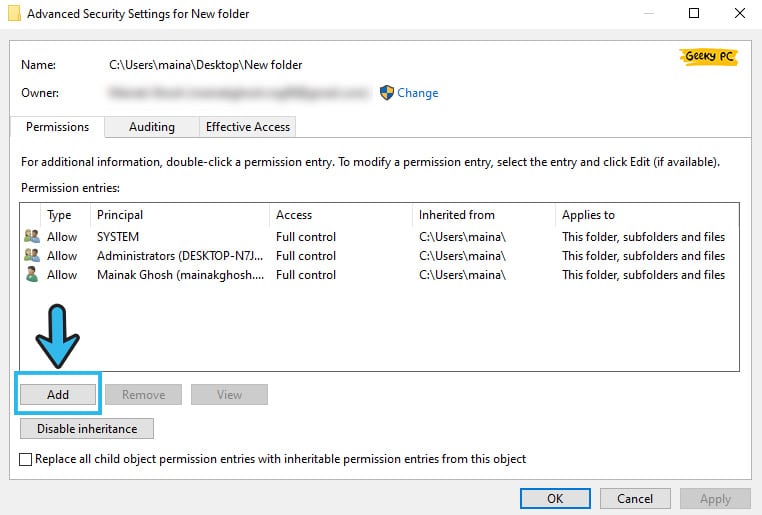
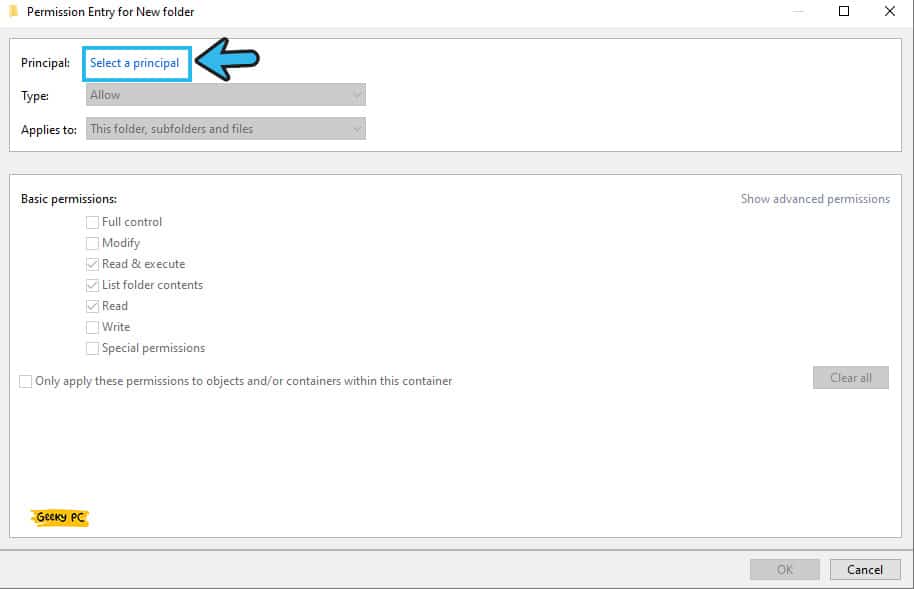
- Step 11: Type “Everyone” in the box under the “Enter the object name to select” header and click on the “Check Names” button.

- Step 12: Click “OK” to save the settings and exit from the window.
Not just in Windows, the file privilege error can even occur in Steam, especially if you use this platform to play and live stream your gaming stints.
And if you are facing the same issue, follow our comprehensive guide to fixing the missing file privilege error in Steam in no time.
10. Tweak With Command Prompt
Besides changing the ownership of the folder, you can simply change the access path of the folder to fix the “Failed to enumerate objects in the container access is denied” error in Windows devices. And you can easily do it through the command prompt app in a few simple steps.
- Step 1: Press the “Windows Key + R” buttons together to launch the “Run” dialog box.
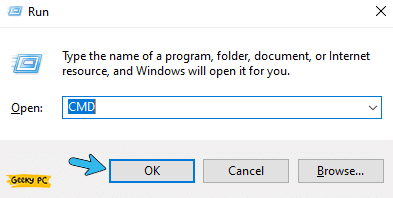
- Step 2: Type “CMD” in the designated field and press the “Ctrl + Shift + Enter” buttons altogether to launch the “Command Prompt” app with administrative privilege
- Step 3: Once the black “Command Prompt” window appears, type the “
takeown /F X:\(Full Path Of Your Affected File)” command and press the “Enter” button. - Step 4: Now type the “
takeown /F X:\(Full Path Of Your Affected File)/r /d y” command and press the “Enter” button. - Step 5: Type the “
icacls X:\(Full Path Of Your Affected File)/grant Administrators:F” command and press the “Enter” button again. - Step 6: Finally, type the “
icacls X:\(Full Path Of Your Affected File)/grant Administrators:F /t” command and press the “Enter” button. - Step 7: Once all the operations are done, type “Exit” and hit the enter button to close the app.
- Step 8: Now, reboot your system and check whether you are still getting the accessibility error.
What Is The “Failed To Enumerate Objects In The Container” Error?
The “failed to enumerate objects in the container access is denied” error message typically pops up in Windows devices when you mainly try to access a folder through a LAN connection. Although it is quite a common error in Windows 10 and 11 OS, it primarily occurs due to mismatched shared file permission.
However, this particular error message can even pop up if you have any bad sector in your HDD or SDD. A corrupted sector in your hard drive can also interfere with the administrative privilege in your system to restrict any user from gaining control of the affected folder located in the corrupted sector.
Conclusion
You should first start with the generic methods we have listed above to fix the “failed to enumerate objects in the container” error in your Windows device. But, if the generic methods are not working, you should proceed with the advanced tweaks. However, it is better to create a “System Restore Point” beforehand to safeguard your data.
So, these are all the solutions we have to resolve the accessibility issues in Windows devices. If you think you have any other practical solution, feel free to drop your valuable feedback in the comment box.
FAQs
Q. How do you fix failed to enumerate objects in the container error?
You should start by updating the Windows OS and disabling the Windows Defender antivirus first to resolve this issue. And then, you should perform the “chkdsk” command in your HDD or SDD to know if there is any bad sector in your hard drive. If nothing is working, you can also manually change the ownership of the affected folder to gain access.
Q. How do I fix error application security?
Application security errors can be easily solved by creating a new user account on your Windows device and regaining its access. Besides, you can also tweak the security settings of the affected folder to reassign access to a specific user profile. You can also change the access privilege by changing the UAC settings.
Q. How do you fix you don’t have permission to access this folder?
Right-click on the affected folder and click on the “Properties” option. Now, navigate to the “group or username” option located under the “Security” header. You should now click on the “Advanced” option and then the “Change” option to proceed further. Lastly, type your user account name, check the box beside the “Replace owner on sub containers and objects” option and then click the “OK” button to save the settings.
Q. How do I give the administrator permission?
Open the “Properties” tab by right-clicking on the affected file first. Now, go to the “Security” tab from the header selection menu and click on the “OK” button. You should now go to the “Advanced” section and choose a username. Finally, put a tick mark in the box beside the “‘Replace all child object permission entries from this object” option and click on the “OK” button.
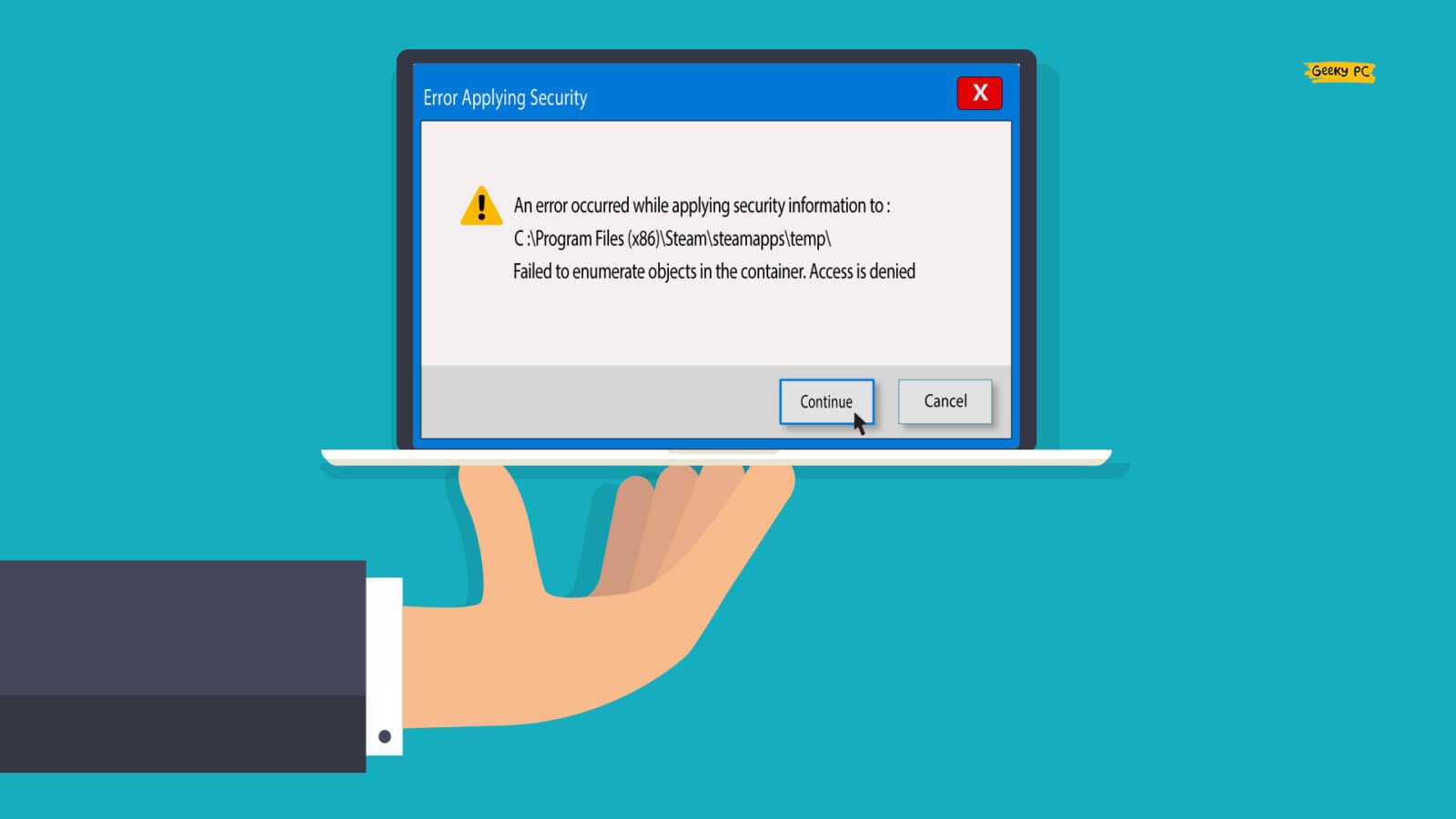


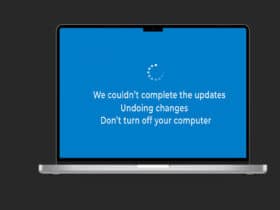
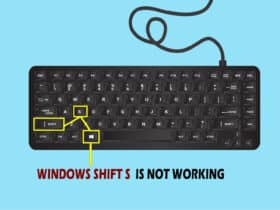
Leave a Reply
View Comments